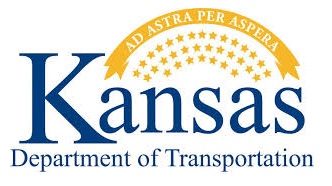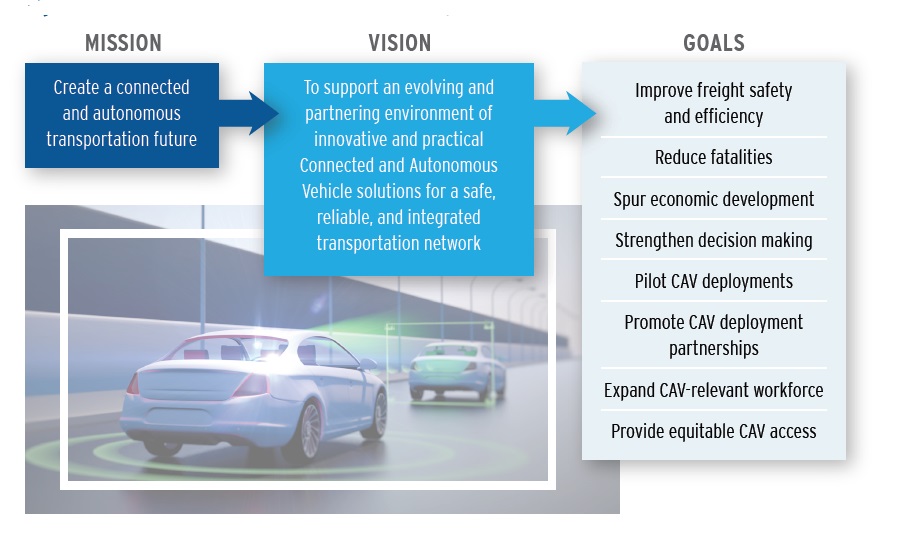Kansas DOT and HNTB
The evolution and deployment of connected and autonomous vehicles, along with needed infrastructure and emerging technology systems to support them is not a challenge for departments of transportation alone. It will require a significant transformation for nearly every state agency. That's why Kansas has taken a collaborative and inclusive approach to envisioning the future of CAV for the entire state.
Most states begin their CAV planning solely through the department of transportation. The Kansas project incorporates all state agencies to embrace a statewide team approach.

Simple Goal: Get Started!
Like other states, we began by seeking a basic understanding of where Kansas stood on emerging technology issues and where it might like to go. We wanted to raise awareness of the innovations coming to our state, help our state agencies consider how these changes might affect them and inspire them to start thinking about preparing for — and even shaping — the technology changes ahead.
Our Kansas Statewide Connected and Autonomous Vehicle Vision Plan serves as the foundation for advancing emerging transportation technologies in the state. Our stated mission is to create a connected and autonomous transportation future. The vision: To support an evolving and partnering environment of innovative and practical CAV solutions for a safe, reliable and integrated transportation network. Among the goals:
■ Improve freight safety and efficiency
■ Reduce fatalities
■ Spur economic development
■ Strengthen decision making
■ Pilot deployments (e.g. safety and/or communications focused)
■ Promote deployment partnerships
■ Expand -relevant workforce
■ Provide equitable access
We were dedicated to simplicity and clear communication, as well. We wanted to produce something anyone could pick up and read quickly to understand where the state needs to go, and we achieved that. The core of our final vision report is only 10 pages.

Collaborative Approach
For Kansas, we began by building trusted partnerships — a truly collaborative approach that could help us leverage resources, knowledge and funding across the state and become more efficient and effective.
We invited multiple Kansas state agencies to participate, including highway patrol, traffic safety, agriculture, insurance, commerce and others.
We also included private vendors and agencies, such as AAA, Ford Motor Company, Garmin and UPS, all with ties to Kansas. And we welcomed the regional governments from our two largest metropolitan areas — Kansas City and Wichita.
We invited academia from Kansas State University and the University of Kansas, along with representatives of the Kansas military installations at Fort Riley and Fort Leavenworth. Some weren't interested, but most were enthusiastic. As others heard of the effort and asked to get involved, we welcomed them, too. Having a diverse and inclusive task force was critical to our success. It also promoted transparency, which always increases trust and willingness to help.
Agency Blueprints Stand Out
In addition to providing a statewide vision, mission and goals, we gave each state agency a simple, two-page CAV starting point for their own planning. The real highlights of our report are the agency blueprints created for each state organization — from the Turnpike Authority and the Insurance Department to the Department of Commerce and even our state legislators.
Each blueprint covers the agency's specific CAV challenges, opportunities, system or data needs, potential strategies, cost and funding, partnership opportunities, educational audiences, immediate actions, timeline and performance measures. The blueprints give them a tangible starting point for the next phase of action planning and implementation.
Process Includes Assessment and Working Sessions
We started the planning process with a 29-question survey. We asked state agencies and other stakeholders about their level of knowledge on CAV technology, the expected timeline for its impact on their agency, its effect on their own agency goals, the role their organization is expected to play and what they are doing to address the potential CAV impacts.
With this knowledge as a starting point, we conducted four half-day task force workshops. That's where the bulk of the work was done to lay out a CAV vision for the state and begin adding specifics to the blueprints.
Each session involved a balance of knowledge building and practical collaborative work. We covered the survey results, case studies from other states, legislative requirements and current Kansas projects during the workshops.
We also had presentations on CAV projects currently in play in the United States and heard about innovations coming from our industry representatives.
Lessons Learned
If you're considering a similar CAV planning effort, we suggest making sure your current leadership is 100 percent behind the plan before you start. Proving the immediacy of the need for this kind of planning also can be an obstacle, especially when you're asking state agencies to voluntarily participate in some fairly intense working sessions.
HNTB was able to bring a fresh perspective and also invite their own industry partners and vendors into the discussion. Those partners — like General Motors, Virgin Hyperloop and Cisco — gave us legitimacy and provided an important industry point of view to task force members. They helped us understand how imminently the effects of CAV technology would begin affecting Kansans, and they also shared their experience with moving related legislation forward in other states.
Next Steps
Several activities are happening already as a result of the plan:
■ We are planning a pilot project in Topeka using IoT to communicate from Kansas DOT trucks to the roadside. We'll be collecting KDOT maintenance vehicle data and considering how to manage and use it.
■ Another pilot will test a wind warning system for high-profile trucks on Interstate 70 on the western side of the state.
■ Already underway — and reinforced by our CAV vision — is an upgrade to the state's fiberoptic network that will assist in data transfer.
■ In addition, a truck parking information system went live across the state just as our report was being finalized.
■ Spurred by this activity, a new group associated with Wichita State University and AAA is presenting a seminar series on autonomous vehicles called Technology Takes the Wheel.
Our plan also includes a list of CAV project possibilities for the next three years. Completing a few successful pilots will help us show early wins to the residents and businesses in Kansas.




